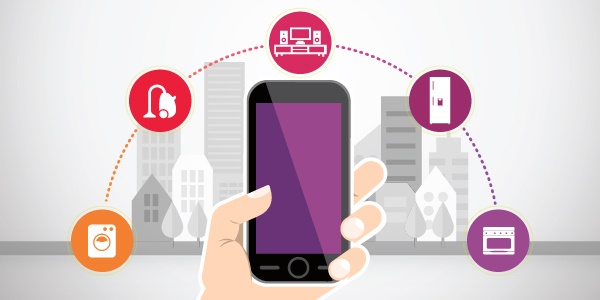
The internet of things has been the buzzword in technology for years, but the trend seems to be the hottest and most spoken about in 2015. Research group Gartner predicts that 4.9 billion connected devices will be in use this year, and the number will reach 25 billion by 2020. Moreover, according to a 2013 survey by The Economist, over three-quarters of companies are either actively exploring or using the IoT.
So what is the Internet of Things (IoT), and what does it have to do with the TV market? Is a Smart TV an IoT device?
IoT is described as the ability to connect everyday devices, say, your smoke detector or your toaster, to one another, and to the internet, aiming at a better, smarter, more economic service. Another way to picture IoT is as the network of networks - a layer of digital information that covers the physical world. What can this layer do? Store data, lots of it, about our habits, preferred home temperature, cooking schedule, etc.
And to recap, what exactly is TV Everywhere?
In the last decade, consumers have dictated the way they want to watch their content. In one word: anywhere. In two words: anywhere, anytime. Innovative solutions connect between our devices: mobiles, tablets, TVs, laptops and desktops – so we can carry and consume our content everywhere. But these solutions offer more: in order to personalize the ultimate content experience, our technologies wrap these devices with a layer of digital information which stores data on our favourite shows, on our preferred device and tells us what others have watched and loved.
So actually, there are a lot of things in common between these two worlds:
Big Data.
The ability to store huge amount of data about users’ habits and preferences is common to both IoT and TV Everywhere solutions. SmartThings for instance is a network of sensors placed in various devices around the house, connected through a mobile app which shows data about temperature or motion in the house. TV Everywhere solutions offer various levels of data-based recommendations, or in other words viewers are invited to watch content tailored for their preferences and habits - based on information which was collected.
Connectivity.
The Smart Home solutions echo the users’ demand for a “one stop shop solution”, which will help them through their busy lives. Who wouldn’t want to be able to operate the washing machine and the oven – at the same time - while driving home from work? The same goes for the TV world. Gone are the days when travelling means a long session of movie downloads ahead of a long haul flight, or placing post-it notes around the house to remember recording the series you’re about to miss. The mobile device is now connected to the service provider’s head-end, which controls users’ set top boxes, or in other cases they can easily stream content anywhere.
Business Opportunity.
As the Economist research puts it, the IoT solutions are “platforms for new business services” – which will in turn generate new revenue streams. As for the TV industry, more video and more platforms could mean more ads and revenues, as indicated in January’s Standard Media Index which showed a decline in ad spending on broadcast networks, while digital spending rose 30%.
Security.
The risks posed for personal, sensitive data stored on servers or on the cloud are countless. The Cyber-attack on the Sony Studios late last year is one example of what could happen if personal and commercial data, together with premium content – falls into the wrong hands. In a recent article, The Guardian wrote that the more secure the Smart Home is (with separate passwords to operate different connected devices) - the more complicated the life of the end user will be. As mentioned in our CEO’s post, the issue of privacy and security troubles the TV market as well – how can we avoid the next potential Sony hacking attack?
Many other features are in common between the IoT and the TV Everywhere markets, but some big differences are important to note as well. The main difference derives from the core purpose of TV Everywhere. A connected toaster, for instance, needs far less information to process about the user’s preferences, than a discovery platform such as COMPASS. On the same token, information about the preferred washing machine program doesn’t need to be shared with friends. On the other hand, connecting between electric appliances which work on different technologies, by different makers can be a sophisticated and complicated process. IoT TV would be a challenge in any milieu.
**
And so, looking ahead to the next few years – will the TV market and Internet of Things continue to evolve on parallel routes, with some meeting points along the journey? Should the TV market follow the developments in IoT – or is it already a leader?
One junction where the two could meet is applications. A smart TV Everywhere app designed by telecom service providers can include features applicable for the smart home. This way, the provider may choose to unite, along the way, his various apps to control home products, including TV. Think about it: why not program your backyard irrigation system and your favourite shows through the same app?
Samsung’s Smart Home can be another example, as the company’s Smart TV box is already acting as the main interface to connected devices. Privacy and security issues have already been addressed by the electronics giant when it warned customers that conversations next to the TV might be recorded – hence innovative set-top boxes can indeed play as the heart of the smart home.
While the advantages of linking IoT and TV Everywhere solutions are clear and the answer to the question is smart TV an IoT device is an unequivocal yes, one other question remains unanswered: how smart do we want our TV devices to be? Can they be both super smart and entertaining – or should we leave the innovation alone from time to time, let the odd, unfamiliar show take us by surprise?
As both markets continue to evolve, these questions will keep coming back to challenge our industry. But as long as users are at the centre of attention, and the serious is never left without some fun – these journeys are bound to achieve promising and scalable solutions.

